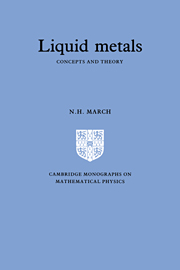Book contents
- Frontmatter
- Contents
- Preface
- 1 Outline
- 2 Pair correlation function and structure factor of ions
- 3 Thermodynamics
- 4 Electron screening and effective ion-ion interactions
- 5 Interionic forces and structural theories
- 6 Statistical mechanics of inhomogeneous systems and freezing theory
- 7 Electronic and atomic transport
- 8 Hydrodynamic limits of correlation functions and neutron scattering
- 9 Critical behaviour
- 10 Electron states, including critical region
- 11 Magnetism of normal and especially of expanded liquid metals
- 12 Liquid-vapour surface
- 13 Binary liquid-metal alloys
- 14 Two-component theory of pure liquid metals
- 15 Shock-wave studies
- 16 Liquid hydrogen plasmas and constitution of Jupiter
- Appendices
- References
- Index
16 - Liquid hydrogen plasmas and constitution of Jupiter
Published online by Cambridge University Press: 19 January 2010
- Frontmatter
- Contents
- Preface
- 1 Outline
- 2 Pair correlation function and structure factor of ions
- 3 Thermodynamics
- 4 Electron screening and effective ion-ion interactions
- 5 Interionic forces and structural theories
- 6 Statistical mechanics of inhomogeneous systems and freezing theory
- 7 Electronic and atomic transport
- 8 Hydrodynamic limits of correlation functions and neutron scattering
- 9 Critical behaviour
- 10 Electron states, including critical region
- 11 Magnetism of normal and especially of expanded liquid metals
- 12 Liquid-vapour surface
- 13 Binary liquid-metal alloys
- 14 Two-component theory of pure liquid metals
- 15 Shock-wave studies
- 16 Liquid hydrogen plasmas and constitution of Jupiter
- Appendices
- References
- Index
Summary
In this chapter, a discussion will first be given of the theory of liquid hydrogen plasmas. Following early work on liquid metals as two-component systems, in which the semiclassical Thomas-Fermi approximation was used (Cowan and Kirkwood, 1958) to find pair-correlation functions for ions and electrons, March and Tosi (1973) described a fully quantal approach to this area which has been described in Chapter 14. This has subsequently been developed in a number of groups, especially through the work of Chihara (1984) and of Dharma-wardana and Perrot (1982). This two-component approach to a pure liquid metal and its correlation functions is, of course, to be contrasted with an approach to structure and forces as in Chapter 5. There the ions were treated as a one-component assembly in which, however, the effective interactions were mediated by the conduction electrons. In the two-component theory, the ions may be assumed, above the melting point of a liquid metal, to be a classical fluid. The electrons, as in Chapters 4 and 7, are usually to be treated as a degenerate quantal fluid.
Following a discussion of integral equation and density functional treatments of metallic liquid hydrogen, some discussion will be given of hydrogen-helium mixtures, their phase diagram, and the relevance to the constitution of Jupiter. Indeed, the properties of these two, the most abundant elements, are important for modeling both the giant planets Jupiter and Saturn. These elements are the major constituents of these planets and are subjected to pressures up to 45 million atmospheres and temperatures up to 20,000 K in Jupiter and about 10 million atmospheres and 14,000 K in Saturn.
- Type
- Chapter
- Information
- Liquid MetalsConcepts and Theory, pp. 309 - 331Publisher: Cambridge University PressPrint publication year: 1990



